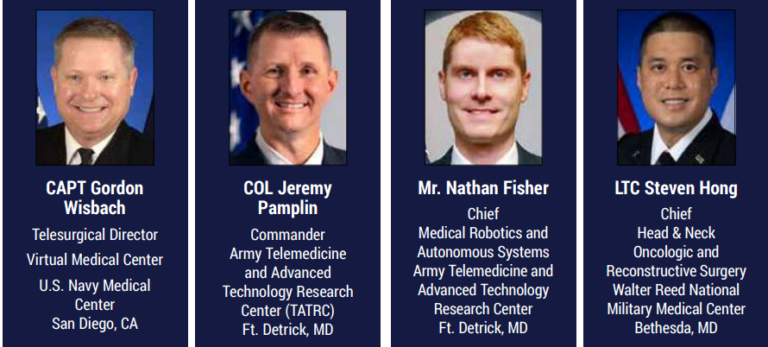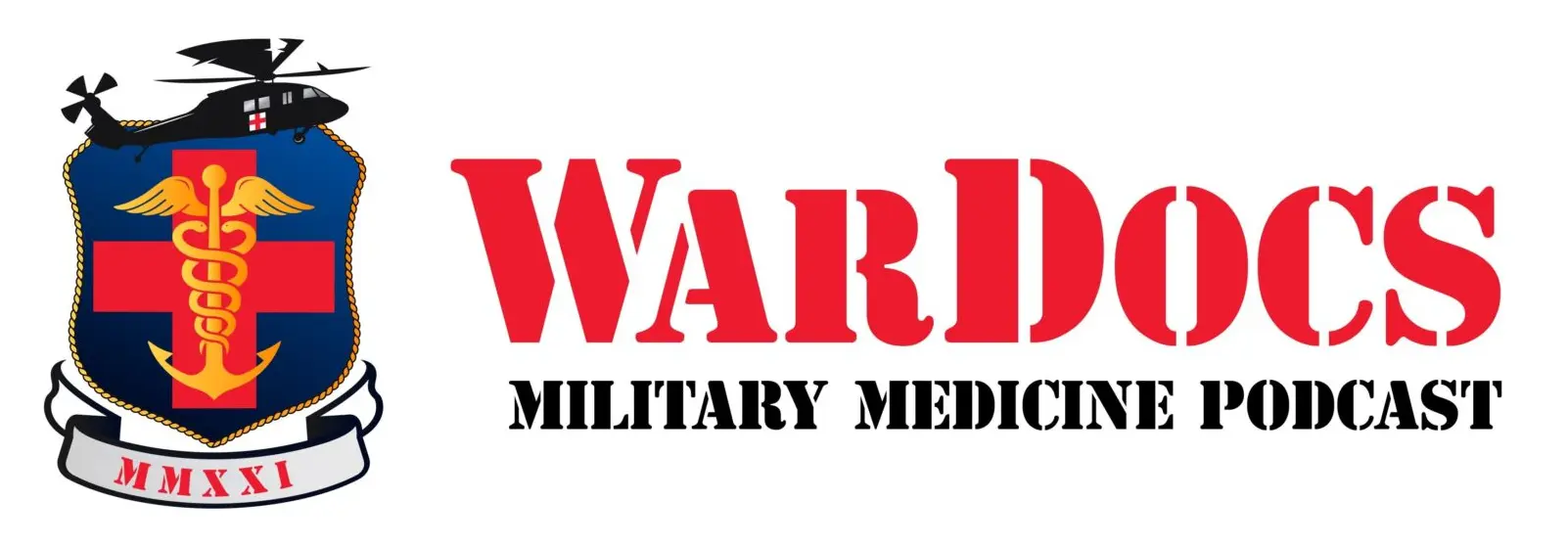
NEXT-LEVEL SURGICAL SUPPORT LEVERAGINGTELEROBOTIC INNOVATION
Combat & Casualty Care had the opportunity to speak with some key leaders who participated in the Inaugural TeleRobotic Surgery Symposium in May 2021 regarding efforts to develop a Military Health System (MHS) roadmap for telerobotic surgery and telementoring researching in the U.S. Department of Defense. Experts remain focused on addressing ways in which automation and technology can enable
surgery in austere locations where surgeons cannot always physically be, increasing casualty survivability and rates of return to battle
C&CC: Speak to TATRC milestones and goals regarding the advancement of telementoring as pertains to telesurgical automation. How can the private sector be harnessed to participate in these needed technology and capability advancements?
Mr. Fisher: CAPT Wisbach and I started communicating about tryingto push surgical telementoring farther forward to be more widely adopted. Our team at TATRC and our Science & Technology partners are developing long-term research projects and tools that we could leverage so we can eventually get to the end user. The intent here is to expand the team to all the relevant stakeholders and help refine the notional roadmap and develop a set of concepts that we can work together to move forward.
The question as to how we harness the private sector has been a conversation that has been going on for a while. We cannot do this without industry partners. I think that the commercial and clinical acceptance of these technologies must be more than just simply DoD driven, but we have the potential to affect the trajectory of these technologies to get more clinical expertise and rotations, particularly
in more rural locations.
CAPT Wisbach: We wanted to develop this roadmap with the different key players: the 5G project, JAIC, ISR, TATRC, DARPA, etc., as they develop as research projects. We are focused on the infrastructure and
the A-Team, as I like to phrase it, to move forward. We are looking at this technology and we know it has great benefit but what are early use case scenarios and early areas of adoption? If you use medical
robotics as the analogy, you have prostatectomy that became the standard of care around 2006. That allowed robots to be populated in the hospitals and that began the new era. But without prostatectomy
it would have been rolling the boulder up the hill continuously. Here we are, what are those cases? I think maybe rural hospitals where you have under resourced surgeons doing good work but they cannot get their specialists and have the outcomes they need. You can correlate that to the Role 2. If we can identify where we think we can get the most traction on a clinical standpoint with actual changing care and adoption. To just to kind of focus, there is a phased approach where you have the telementoring as a foundation, and then surgical telerobotic surgery infrastructure, and then application technology.
LTC Hong: I think the military is in a unique position compared to the civilian side. The problem in the U.S. I have learned is the nontechnical barriers. The medical legal and credentials between states and hospitals in the U.S. will be the biggest challenge, especially when engaging in the rural setting. I think having these developments still ongoing and pushing forward telesurgery versus telementoring as they
run up parallel tracks. Even though there’s telesurgical mentoring out there already, I think it is important to realize that it is not one size fits all. And there are still so many gaps to address still and questions to answer about telesurgical mentoring. I can certainly tell you, telesurgical mentoring aside, direct surgical mentoring is sometimes hard. The challenge is we are taking, at least residents or folks that have at least some degree of training, and a lot about telesurgical mentoring as applies to guiding to physicians’ assistants and medics to do full blown procedures. I think it certainly can be done.
C&CC: Can you delineate what the tools are needed to establish the foundation of telementoring in support of telesurgical robotics?
CAPT Wisbach: You think about the trajectory of the simplest meansof telementoring so it could be a cell phone, FaceTime, or some kind of limited imagery over which you can offer guidance to somebody,
but is that on official channels and is that reliable? And then, to what depth, can you offer that telemedicine. I would argue that if you start incorporating aspects of telesurgery robotics, the computer assisted aspects of it, then that heightens the telemedicine potential tenfold. So now you have the potential of seeing 3D telestration, seeing the information in depth, very clearly, perhaps having more reliable communication, and then layering in different technology. I would argue that robotic system-based telementoring gives us a platform to add in all computer-assisted surgery, data analysis, and guidance. A cloud-based phone application call MyIntuitive tm, made by the same company that
makes the da Vinci system, that allows you as a surgeon to see how long you are taking to do certain steps of a procedure, what instruments you are using, comparing you to averages collected. Maybe you want to take one instrument and use it less than another instrument, or maybe you can refine your steps so you are more efficient. That kind of learning is available on a computer-assisted platform. I think that this computer assistance adds true power of projecting surgery into the battlefield.
But it is a trajectory and I think it is an important to say that surgical telementoring is just an extension of what we are already doing. You are already telementoring in the field, whether it be a surgery patient or ER telementoring is just an extension of what we are already doing. You are patient, ICU patient, or trauma patient. You are basically doing patient care. So, I think it is important to break down the walls of telemedicine and say telemedicine is as a physician or healthcare provider helping a patient who is remotely located. This could be in all kinds of patient care scenarios, again ICU, ER ward in or out of the hospital, in or out of the OR. The construct in a hospital is that you have walls and rooms and only certain providers go into those rooms. Telemedicine changes that. There are no walls, so you can vary around your care, based on the patient, the level – cal Center San Diego’s Virtual Medical Operation Center (VMOC), you have great communication. You have healthcare information, you have access to other specialists, and you can vary your level of communication, either through phone, VTC (spell out), or possibly through a remote console.
LTC Hong: Because of the unique character of MHS physicians, wesometimes end up in a right place with the right opportunity for longenough to develop a robust robotic surgical practice. Certain places you do not develop this as you may be far further away from training. I can clearly see the use of telerobotic surgery within the MHS system, let alone the operational battlefield for medical readiness purposes. We just need to determine what kind of limitations, procedure gaps, and outcomes that would come from telesurgical mentoring in support of telerobotic medicine.
CAPT Wisbach: If you look at robotic surgery and back in 2006-2008 timeframe when the robotic systems were initially being purchased by civilian hospitals, the use case that drove this adoption was the prostatectomy with robotic technique becoming standard of care to avoid open surgery and improving outcomes. What is the catalyst or ‘use case’ that drives this adoption in operational environments or overseas? For telementoring, a powerful use case example is in a Role 2 setting with an intracranial injury and intracranial bleed with need for intracranial decompression with a burr hole, the local surgeon can remote guidance by a neurosurgeon. The challenge is how often does that happen? What is the high volume, or a high stakes case scenario? The prolonged field care may be a situation where remote expertise assistance is vital as the patient care evolves and may demand telementoring, and maybe telesurgery in the future.
COL Pamplin: I think that we have demonstrated in multiple simulation scenarios the value of telemedicine. We are working on publishing the randomized control data for telemedicine versus no telemedicine during prolonged field care and how it can affect outcomes at least for simulated patients. I think there’s very little doubt that telemedicine and telementoring can help deliver better care, especially when the expertise of that care is not otherwise available. How do you get this technology into places in the future is really the next major step/ I think the way that you do that is you grow it small and you keep expanding that type of capability. We start with it in the training and simulation space like we have talked. I think the strategic documents are starting to come into place, and you allow the expectations that come from the clinicians, from the medics, from the community of interest. This type of support is going to be available to them. You can do scenarios that will demonstrate whether a patient will do better or worse with this type of capability. That will allow the decision makers the freedom of maneuver to start putting in the resources necessary for making this type of capability available on a future battlefield. It is still hard to telementor today, it still takes time. Let us make that problem set easier. Let us iterate upon individual problem sets we identify while we are using the technology.

